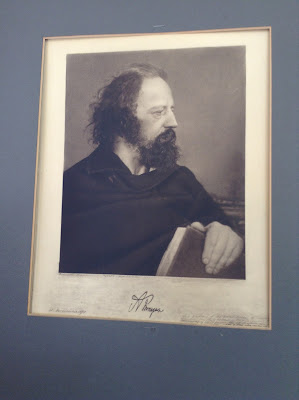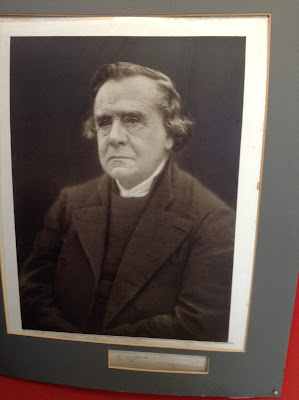The New Forest is a lovely place to visit. Despite its name, there is very little in the way of actual forest, but sweeping swathes of pink heathland, spreading out to the sea. Dappled and piebald ponies wander willy-nilly, oblivious to cars, and there are wonderful old pubs at every turn. It is also a nightmare during summer months, queuing to get through tiny villages, hot cars filled with anxious sightseers agitating their sat-nav for a better route, a quicker route, in fact any damn route than the one they, and everyone else in the sodding world, is on. But of all the wonders and surprises that the South Coast of England affords, a tiny art gallery inside a railway station is possibly the most delightful...
Brockenhurst got its railway station in the late 1850s and took in such routes as Passford Water and Milking Pound Bottom. It also cut the journey time to London down to 4 hours. It was eagerly and gratefully embraced by a rural community that obvious always felt it was going places. Today, Brokenhurst (or 'Brock, Darling' as it is known by the fashionable young 'uns) is a wealthy, artisan-bakery kind of place, and its railway station is remarkably busy and quite big. You often have to change there to get to Bournemouth and down to Lymington for the ferry to the Isle of Wight. Ah, the Isle of Wight - you might see where this is going...
 |
| Helmut Gernsheim (1962) Ida Kar |
This rather dapper looking chap is Helmut Gernsheim, a name that will be very familiar to anyone who has read about Julia Margaret Cameron. Gernsheim was an art historian who had a special interest in photography and he and his wife Alison amassed a vast collection of early photographs, especially works by reasonably unknown (at that time) artists like Cameron and Lewis Carroll. There is a lovely story of what is supposed to have triggered this passion. Whilst travelling across the south of England, Gernsheim found himself caught in bad weather and took shelter in the waiting room at Brokenhurst. He could not believe his eyes...
"While waiting I was suddenly struck by familiar faces gazing down from the walls. To my astonishment I found no fewer than eleven autographed portraits of famous Victorians by Julia Margaret Cameron. I must admit that I was rather puzzled to see these photographs decorating a dingy railway waiting room, of all places, but a moment later I came across the surprising explanation inscribed on one or two of the photographs.
This gallery of the great men of our age is presented to this room by Mrs Cameron in grateful memory of this being the spot where she first met one of her sons after a long absence of four years in Ceylon. 11th November 1871."Obviously I wanted to go and have a look...
In defense of Brockenhurst Railway Station, these days it is not dingy at all. Small and busy, the ticket office has the plates from two steam trains over the two windows, very appropriately labelled 'Freshwater' and 'Farringford', the trains that took passengers down to the Isle of Wight ferry. In Gernsheim's notes he says that the original photographs were removed to head office at Waterloo Station in the 1930s but that copies were there when the book was published in the 1970s. I don't know how hopeful I felt as we investigated, but lo and behold on either side are two wall mounted cabinets with the prints inside.
 |
| Henry Wadsworth Longfellow, at Brockenhurst Station |
A little label in the cabinet reads 'These photographs are very careful copies of the original photographs by Mrs JULIA MARGARET CAMERON and were bequeathed to this station. The originals, which were fast fading away, are retained carefully by the Headquarters of SOUTHERN RAILWAY.' As a side note, I have tried to find where the photographs are now held, but no-one has any idea in head office, which is a great shame.
 |
| Massive beards of the New Forest - No.1: Henry Taylor |
The prints are beautiful quality and the cabinets are nice if a little retro, but they don't detract from the images. They are kept behind locked sliding doors and I must thank the staff for having the patience to unlock the cabinets for me, so I could take the pictures.
 |
| Artist's impression of a JMC photograph |
For some reason, one of the photographs, presumably Beatrice Cenci (May Prinsep) (1866) (left), was missing from the reproductions and instead a print of a drawing of it appears in its place. I'd love to know why - maybe the original had become too faded by the time of their replacement, so a drawing had to be done instead. It's a very spirited attempt, but I wonder why it wasn't just left out. Maybe it was felt that Mrs Cameron had left a 'collection' and that should be respected as a vision that should remain intact. As it is, what is May Prinsep doing in a collection of 'great men' (Cameron's own words)? I have a theory that Cameron often used the word 'men' in terms of 'person', in the old sense of the word. There is a blog I keep meaning to writing on Cameron's tricksy language, but when it came to 'men', I don't think she meant it to exclude women too.
 |
| Everyone's favourite Dirty Monk! |
It is impossible not to feel the same delight as Gernsheim at the sight of the Cameron photographs in such an unusual setting. Many of the faces that grace the walls are possibly unknown to the average traveller these days, not because we are a bunch of numpties, but because people like this aren't exactly everyday celebs...
 |
| If you can name this man, I'll be very impressed... |
So, if you find yourself in Brockenhurst with a few minutes to spare, make your way over to the ticket office by the Italian restaurant and the car park. There, behind some pot plants and leaflet holders are the collection of images Cameron left in gratitude to the place her son returned to her. I often think of Cameron's art as a replacement for her children, to fill that creative, nurturing piece of her life when her nest emptied. It is therefore appropriate that she left some of her 'children' in the place where she welcomed back her beloved son and created a haven of Victorian art in a bustling world.
(The chap is Samuel Wilberforce, Bishop of Winchester, in case you were wondering. I'm sure you all knew that though, you clever bunch.)



I think you are mistaken, the mystery man in the photograph is my maiden great aunt Bessie.
ReplyDeleteWas it the lack of beard that gave it away?
DeleteWhat an interesting find! It's seems typical that they would have lost the originals (no doubt during the British Rail era). One thing that struck me is the way that artists can bestow what you could almost call a "blessing" on an otherwise mundane place (I think there's a prison in America that has a Dali sketch and of course Banksy is forever leaving his mark around). The prints do look great - the artist's copy of the missing one is very beautifully done. I wonder if Tennyson himself would have passed through the station on his way from Aldworth down to Farringford. I presume he would have done this bit of the journey by train? The presence of the "Farringford" sign might suggest so. The photograph of Tennyson looks like it has his signature on it.
ReplyDeleteDo you have a title list of the 11 images Gernsheim mentions?
ReplyDeleteDo you have a title list of the 11 images that you saw and that were mentioned by Gernsheim?!
ReplyDeleteSadly not, although I'm guessing the copies they put up are copies of the originals. When I tried to track down the originals, no-one knew anything about them at the head office or even that they had replaced the originals with copies. I will continue to seek out contemporary accounts to see if anyone mentions them...
Delete